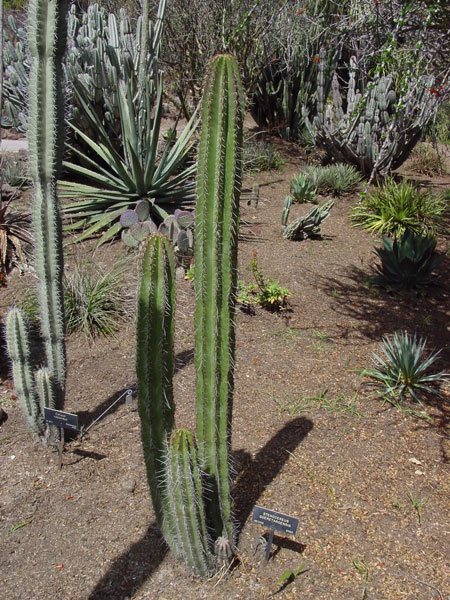Stenocereus queretaroensis
Stenocereus queretaroensis
Stenocereus queretaroensis is a species of the genus Stenocereus in the cactus family ( Cactaceae ). A Spanish common name is " pitahaya de Queretaro ".
Description
Stenocereus queretaroensis growing tree structure with numerous candelabra -like branching shoots and plant height reaches 3-7 meters. It is formed a distinct tribe. The green, sometimes reddish, shoots have diameters of up to 15 centimeters. There are seven to nine blunt, slightly rounded, showy fins present, which are not notched. The located on them areolae are covered with brown to black, felt-like hairs. The one to two unequal white to gray central spines, which may be absent, are up to 3 inches long. The lowest of them is longer. The five to six spines are at first whitish and greyish later. They reach a length of 5 to 30 millimeters.
The funnel-shaped, fragrant flowers appear near the shoot tips. They open at night and stay open well into the next morning. The flowers are 7.8 to 8.4 inches long and have a diameter from 4.5 to to 6.7 centimeters. The flower tube is slightly bulged in the nectar chamber. The Perikarpell and the corolla tube are bald. The more or less spherical, green or red to purple colored fruits reach a diameter of 5 to 6 centimeters. They are set with thorns and hairs. The flesh is white or red to purple.
Distribution, systematics and hazard
Stenocereus queretaroensis is common in the Mexican states of Querétaro, Guanajuato, Jalisco, Colima and Michoacán in deciduous forests and dry bush at altitudes of up to 1800 meters. The first description was in 1891 as Cereus queretaroensis by Albert Mathsson. Franz Buxbaum put the type in 1961 in the genus Stenocereus.
In the Red List of Threatened Species IUCN, the type is known as " Least Concern ( LC) ," ie, than not led at risk.
Use
Stenocereus queretaroensis is cultivated due to the edible fruit.







.jpg)


